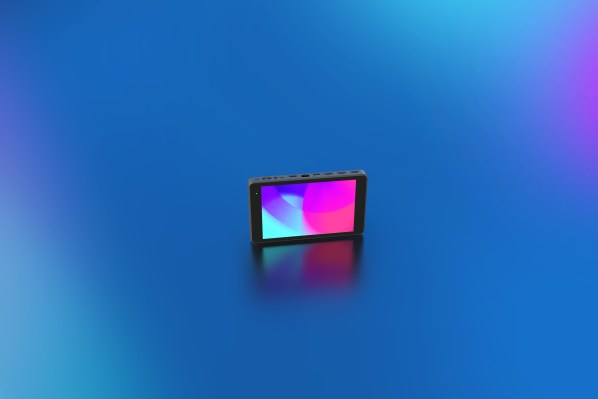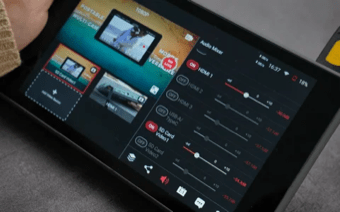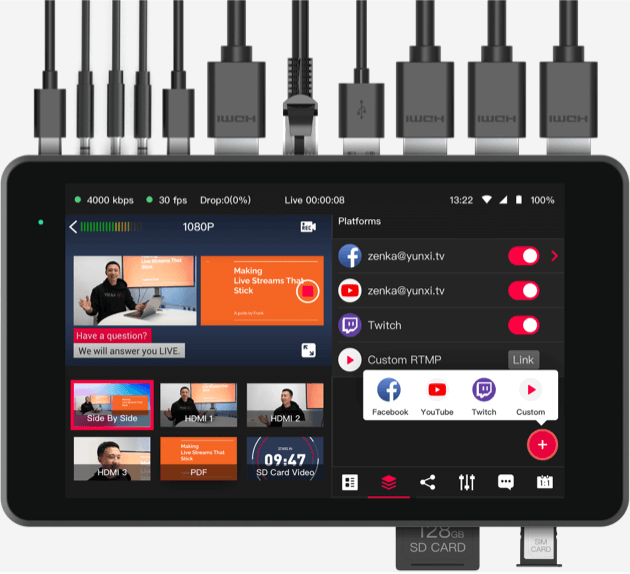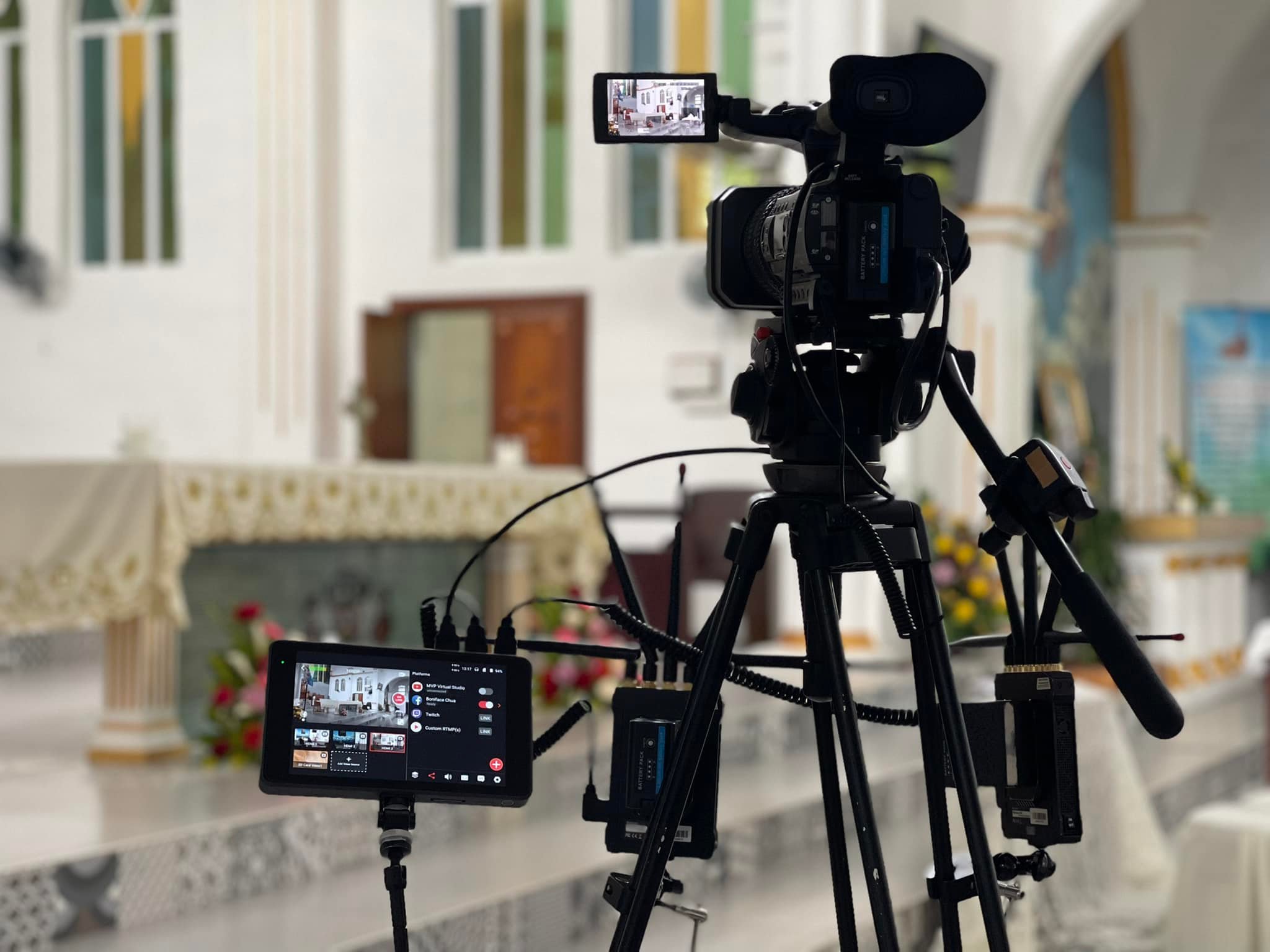Somehow, we all became livestreamers during the pandemic, even if it just meant rearranging our office shelves for a better Zoom background. But the pandemic was also a boon for those catering to clients with slightly more advanced needs, such as those who needed dedicated hardware, be that fancy streaming lights, capture cards or entire live production setups. Atem, Elgato and company probably never saw as many searchers on their websites as during the middle of 2020. Another player in this field is YoloLiv, which offers both hardware and software tools for creating livestreaming productions. The company recently launched a number of interesting software updates and sent us its YoloBox Pro to give it a try.
What makes the YoloLiv boxes stand out is that they are standalone devices that you can use to run a live production with multiple cameras, all without needing a dedicated desktop or laptop to stream.
You can basically think of the YoloBoxes as very thick Android tablets (and they do, in fact, run Android). The Pro version is the flagship model, with an 8-inch screen, three HDMI inputs for bringing in camera feeds, a USB port for connecting a webcam and an SD card reader for bringing in pre-recorded video and saving your recording. There’s also a line in port for bringing in audio and a USB-A port that lets you use the device as a webcam and connect it to a computer and an HDMI out port for a dedicated monitor. To connect the Box to the internet, there’s an Ethernet port for wired connections and Wi-Fi, and there’s even support for LTE connections.
The system runs on a Qualcomm 660 chip and dedicated media encoders, and in my testing, all of that works just as advertised, with up to 60 frames per second.
The company also offers the 7-inch YoloBox with two HDMI inputs and one USB port for a webcam, but without the ability to use the entire unit as a webcam. The newest member of the family is the 5.5-inch YoloBox Mini, with just one HDMI port and one USB port for adding a webcam. That makes the potential use cases for this a bit limited, but unlike the standard non-Pro YoloBox, you can use it as a webcam. Most likely, that’s because both the Pro and Mini use Qualcomm’s 660, while the YoloBox uses the less powerful 625 chipset.
The company is also about to release a new box — the Instream — for streamers on Instagram and TikTok, with a focus on vertical video.
As somebody who typically uses OBS or Restream Studio for producing livestreams, moving to the YoloBox took a bit of getting used to. But I can definitely see the appeal of the YoloBox. Setup takes a few minutes. Connecting cameras is a plug-and-play affair — and once you’ve entered your YouTube, Facebook or Twitch credentials, you’re good to go. If you want to get fancy, you can build your own picture-in-picture, side-by-side and split views and easily switch back and forth between them during your show.
One thing that impressed me is that with every software release during my testing phase, the company launched useful new features. Most recently — and most importantly for somebody who livestreams interviews or podcast recordings — you can now invite people to your shows.
However, if you use the device as a webcam, one thing you have to keep in mind is that there is a slight delay in processing all of the video feeds. We’re talking about maybe half a second, but that’s enough to make conversations harder, and if you don’t feed your audio through the YoloBox but through your computer, it’ll be out of sync. This isn’t the most likely use case for these devices, but it’s worth keeping in mind.
Where the device shines is when you use it to produce a live event. Setting up different views is easy and you simply switch using the touch screen. You can set up lower thirds or any other text on the screen and case it in and out as needed, assign names to presenters, etc. There’s a scoreboard, too, for when you’re streaming your school’s football games. Of course, there are also built-in countdown timers and virtually every other feature you would expect. Writing your lower thirds on the touch screen gets a bit old after a while and I’d like to see more features that would make it easier to recycle them from stream to stream, but that’s a minor issue.
A few days ago, YoloLiv launched version 2.0 of the software package for the Pro, which adds a couple of features that I missed while using the device. The most important of those, at least for me, was the ability to copy, reorder and prioritize overlays, and for those who use it to stream sports (or e-sports), there’s now support for instant replays.
Unsurprisingly, all of this takes a fair bit of energy. The YoloBox Pro is powered by a 10,000 mAh battery, which the company says should last about three hours. I got closer to a bit over two hours in my tests, but I was also trying lots of features at the same time. For some features, including adding guests, YoloLiv recommends that you don’t use an external webcam but only the HDMI inputs, and in my experience, that’s correct. The webcam seems to need quite a bit more compute power, and some of these new features do push the device to its limits.
Still, I’ve been impressed by how the company is obviously listening to user feedback and improves the device with every update.
There is clearly a space for a device like this. At almost $1,300, you’re either a very dedicated amateur or maybe a nonprofit that doesn’t need a larger setup, but if you’re good with the number of inputs, I can’t really think of another easily portable solution like this (unless you want to bring a laptop and switcher and a lot more gear). I’m sure professionals will always prefer the hardware controls of an ATEM Mini Pro from Blackmagic (or its larger brethren). But as an all-in-one device, the YoloBox Pro doesn’t really have a lot of competition right now.



